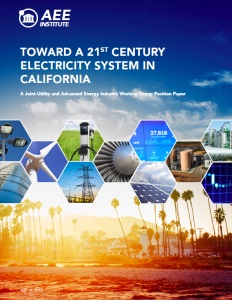
by Brianna Crandall — August 31, 2015—New regulatory frameworks are needed to move California toward a 21st century electricity system, a broad working group of utility and advanced energy company executives said in a position paper released this month by the nonprofit Advanced Energy Economy Institute. Regulators need to assess the pros and cons of different models for operations, pricing, and revenue to provide a platform for new technologies, products, and services for customers while maintaining the viability of investor-owned utilities to provide reliable and affordable electric service for all, the paper said.
According to the position paper, California’s portfolio of policies, statutes, and regulatory actions, existing and proposed, has set the state on a path to a dramatically different electric power system in the future. In a vision developed by the working group, the role and functions of the electric grid will be significantly different by 2030, driven by changes in customer expectations, environmental and other policy objectives, and the rapid advancement and deployment of new technologies.
This vision is the culmination of trends already underway:
Innovation in product and service delivery: Customers now have many more options to manage their energy costs and where their electricity comes from. These include energy efficiency, demand response, rooftop solar, electric vehicles, on-site batteries, control technology for air-conditioning and lighting, and building energy management systems. Enabled by these technologies, customers are able to provide services to the grid. Utilities will need analytical constructs to determine the value of such services and customers will need innovative products as they play an increasingly important role in grid management.
System design and technology: The 21st century grid will require management of significant amounts of utility-scale renewables, more holistic integration of distributed energy resources, and increasing third-party (non-utility) solutions that help maximize value to customers. The grid must be designed to accommodate rapid evolution in available technologies as well as emerging technologies. Utilities will need to increase investment in hardware and analytics, as well as develop tools to optimize the contribution of customer-side resources. Regulators will need to facilitate these changes by supporting infrastructure investments, allowing experimentation, and requiring development of standards and open protocols to ensure interoperability and integration, while also addressing cybersecurity.
Regulatory framework, incentives and revenue mechanisms: Regulators will need to determine how to equitably cover and share the costs of essential grid services while also supporting customer-level options and achieving state policy objections. The California Public Utilities Commission (CPUC) has begun to address these issues through individual proceedings. As the changes become more profound, it will become necessary to consider more fundamental changes. Regulators will need to identify issues that currently impede — or could enable — evolution from existing models to new ones; determine what functions and services are most appropriate for the regulated market versus the competitive market; and consider ways to integrate or coordinate the various regulatory proceedings into a comprehensive framework.
Companies engaged in the working group encourage the CPUC and the California Energy Commission to consider these factors as they work to accelerate the transition to a high-performing electricity system in California for the 21st century.
In the position paper, the working group encouraged the CPUC to explore two different operational models for utilities (Distributed System Platform, Independent Distributed System Provider), two different market operation and pricing models (Regional Grid Optimization vs. Distribution Marginal Pricing models), and three different utility revenue models. All of these have significant implications for customer pricing, technology development, and system benefit.
“California is the nation’s leader in climate policy and energy innovation,” said Graham Richard, CEO of Advanced Energy Economy, a national business association. “Now, California has a chance to lead the way in organizing the electric power system to make way for technology innovation and greater customer choice.”
Toward a 21st Century Electricity System for California is available for download from the AEE Web site.




